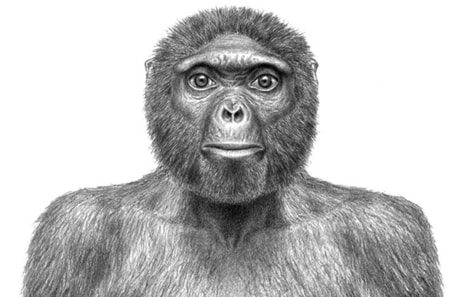The first major analysis of one of the earliest known hominids suggests that humans may not have evolved from apes.
One of the principal investigators, C. Owen Lovejoy, associate professor of biological anthropology at Kent State University in Ohio, said the research reveals that the reverse could be true: Apes might have evolved from the hominids that eventually evolved into humans.
“People often think we evolved from apes, but no, apes in many ways evolved from us,” Lovejoy said. “It has been a popular idea to think humans are modified chimpanzees. From studying Ardipithecus ramidus, or ‘Ardi,’ we learn that we cannot understand or model human evolution from chimps and gorillas.” (See artist’s renditions at right.)
The research is being published in a special edition of the journal Science.
An international team of 47 scientists for the first time thoroughly described Ardipithecus ramidus, a hominid that lived 4.4 million years ago in what is now Ethiopia.
The research consists of 11 detailed papers that describe the Ardipithecus fossils that include a partial skeleton of a female, nicknamed “Ardi.”
The last common ancestor shared by humans and chimpanzees is thought to have lived six or more million years ago. Though Ardipithecus is not itself this last common ancestor, it likely shared many of this ancestor’s characteristics.
For comparison, Ardipithecus is more than a million years older than the “Lucy” female partial skeleton of Australopithecus afarensis. Until the discovery of the new Ardipithecus remains, the fossil record contained scant evidence of other hominids older than Lucy.
Through an analysis of the skull, teeth, pelvis, hands, feet and other bones, the researchers have determined that Ardipithecus had a mix of “primitive” traits, shared with its predecessors, the primates of the Miocene epoch, and “derived” traits, which it shares exclusively with later hominids.
Because of its antiquity, Ardipithecus takes us closer to the still-elusive last common ancestor.
However, many of its traits do not appear in modern-day African apes. One surprising conclusion, therefore, is that it is likely that the African apes have evolved extensively since we shared that last common ancestor, which suggests that living chimpanzees and gorillas are poor models for the last common ancestor and for understanding our own evolution since that time.
Primary authors in the project include Lovejoy, who studied the skeletal remains below the neck and helped determine that Ardi could walk upright, but not as well as humans, and could climb trees, but not as proficiently as chimpanzees and other great apes.
Those results among others place Ardi as an important transitional hominid in the evolutionary journey that led to humans.
“It’s another step toward understanding human evolution and completing our understanding,” Lovejoy said. “Ultimately it says something about our place in the world.”
